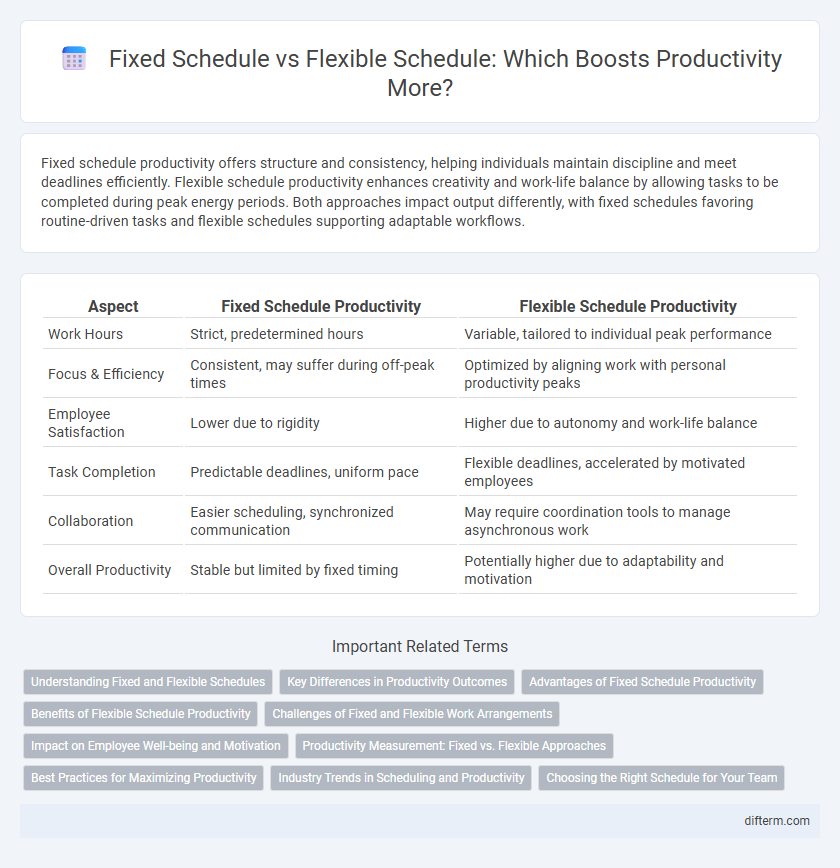Fixed schedule productivity offers structure and consistency, helping individuals maintain discipline and meet deadlines efficiently. Flexible schedule productivity enhances creativity and work-life balance by allowing tasks to be completed during peak energy periods. Both approaches impact output differently, with fixed schedules favoring routine-driven tasks and flexible schedules supporting adaptable workflows.
Table of Comparison
| Aspect | Fixed Schedule Productivity | Flexible Schedule Productivity |
|---|---|---|
| Work Hours | Strict, predetermined hours | Variable, tailored to individual peak performance |
| Focus & Efficiency | Consistent, may suffer during off-peak times | Optimized by aligning work with personal productivity peaks |
| Employee Satisfaction | Lower due to rigidity | Higher due to autonomy and work-life balance |
| Task Completion | Predictable deadlines, uniform pace | Flexible deadlines, accelerated by motivated employees |
| Collaboration | Easier scheduling, synchronized communication | May require coordination tools to manage asynchronous work |
| Overall Productivity | Stable but limited by fixed timing | Potentially higher due to adaptability and motivation |
Understanding Fixed and Flexible Schedules
Fixed schedule productivity relies on predetermined work hours that create consistent routines and clear boundaries, enhancing time management and minimizing distractions. Flexible schedule productivity offers adaptability, allowing individuals to work during their peak energy periods, which can boost creativity and reduce burnout. Understanding the unique advantages of both fixed and flexible schedules enables organizations to tailor work environments to optimize overall employee performance.
Key Differences in Productivity Outcomes
Fixed schedule productivity often results in consistent output due to structured work hours and predictable routines. Flexible schedule productivity can enhance creativity and job satisfaction by allowing employees to tailor work times to peak performance periods. Key differences in productivity outcomes include fixed schedules promoting discipline and time management, while flexible schedules improve adaptability and reduce burnout.
Advantages of Fixed Schedule Productivity
Fixed schedule productivity ensures consistent work hours, enhancing time management and reducing procrastination by establishing clear routines. This structured approach improves collaboration and communication among team members due to synchronized availability. Predictable schedules also facilitate better tracking of work progress and effective deadline adherence, boosting overall efficiency.
Benefits of Flexible Schedule Productivity
Flexible schedule productivity enhances employee well-being by allowing personalized work hours, which leads to higher job satisfaction and reduced stress levels. Studies show organizations embracing flexible schedules experience a 20-30% increase in overall efficiency due to improved focus and better time management. This productivity model fosters creativity and innovation by accommodating individual peak performance times, driving superior business outcomes.
Challenges of Fixed and Flexible Work Arrangements
Fixed schedule productivity often faces challenges such as limited adaptability to individual peak performance times and increased stress due to rigid time constraints, leading to potential burnout. Flexible schedule productivity can encounter issues like difficulty in maintaining consistent communication, coordination problems among team members, and blurred boundaries between work and personal life, which may cause decreased focus. Balancing these challenges requires organizations to implement clear guidelines and support systems to optimize productivity in both fixed and flexible work environments.
Impact on Employee Well-being and Motivation
Fixed schedule productivity provides structure and predictability, which can reduce stress for employees who prefer routine, enhancing their overall well-being. Flexible schedule productivity allows employees to tailor work hours to personal peak performance times, boosting motivation and job satisfaction by promoting work-life balance. Studies indicate that flexible schedules often lead to higher engagement and reduced burnout, positively impacting long-term productivity.
Productivity Measurement: Fixed vs. Flexible Approaches
Fixed schedule productivity metrics emphasize consistent time blocks and standardized work hours, making output easier to quantify and compare across teams. Flexible schedule productivity relies on task completion and quality indicators, enabling adaptation to individual work patterns and peak efficiency periods. Balancing both approaches often results in accurate productivity measurement by integrating time-based tracking with results-oriented performance data.
Best Practices for Maximizing Productivity
Maximizing productivity involves tailoring work schedules to individual needs, with fixed schedules providing structure and consistency that enhance time management and reduce procrastination. Flexible schedules empower employees to work during their peak energy periods, boosting creativity and job satisfaction while accommodating personal responsibilities. Combining clear goals, regular breaks, and technology tools effectively optimizes both fixed and flexible schedule productivity.
Industry Trends in Scheduling and Productivity
Industry trends reveal a growing preference for flexible scheduling as it enhances productivity by accommodating individual peak performance times and reducing burnout. Fixed schedules remain prevalent in manufacturing and service sectors due to operational predictability and streamlined workforce management. Emerging technologies such as AI-driven scheduling tools optimize productivity by balancing flexibility with business needs, reflecting a shift towards hybrid scheduling models.
Choosing the Right Schedule for Your Team
Choosing the right schedule for your team significantly impacts overall productivity, with fixed schedules providing structure and predictability that benefit routine tasks and maintain consistent workflow. Flexible schedules offer autonomy and adaptability, often enhancing creativity and reducing burnout by accommodating individual work rhythms and personal responsibilities. Evaluating team roles, project requirements, and employee preferences is essential to optimize productivity and foster a balanced, efficient work environment.
Fixed schedule productivity vs flexible schedule productivity Infographic

 difterm.com
difterm.com